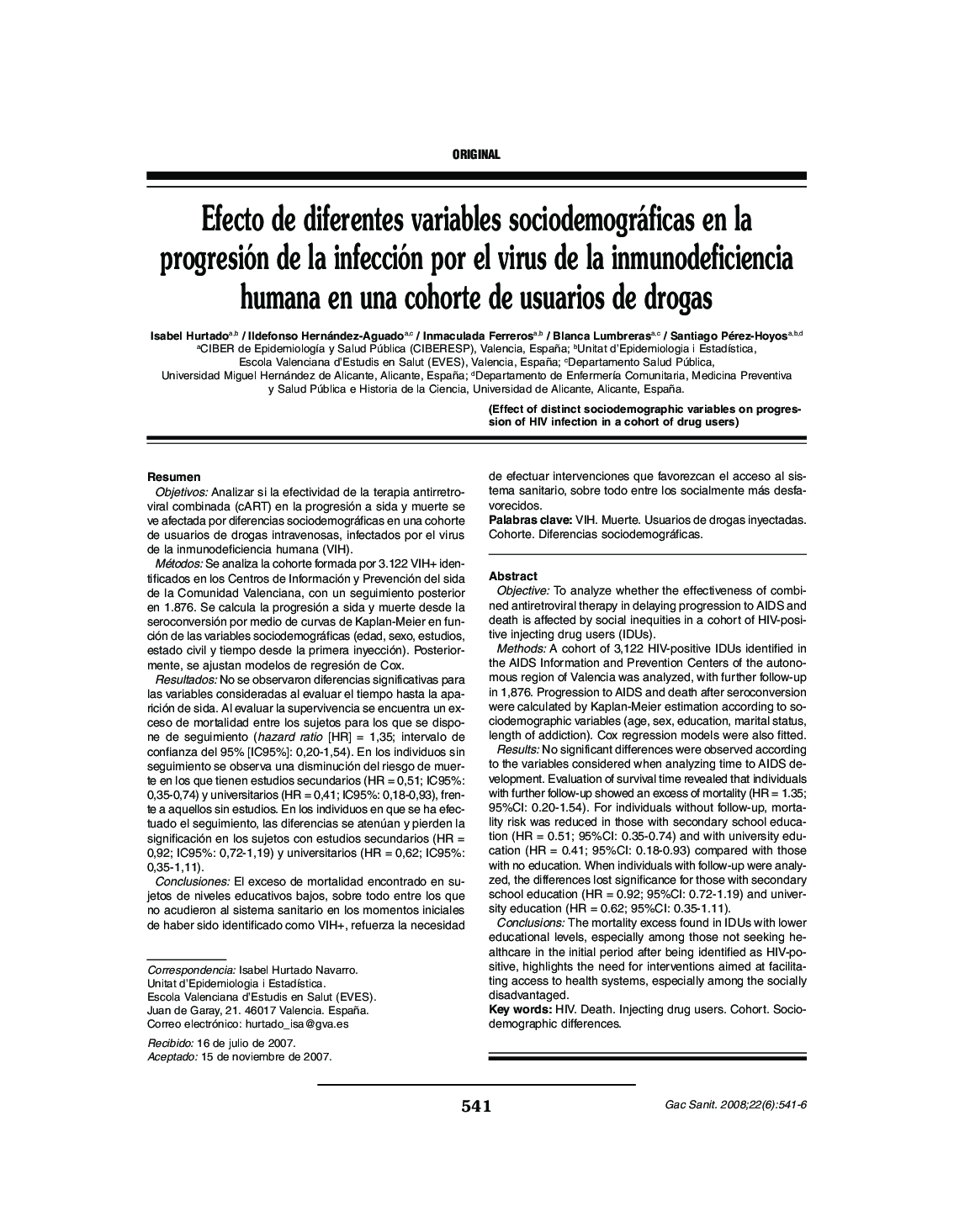| Article ID | Journal | Published Year | Pages | File Type |
|---|---|---|---|---|
| 1074301 | Gaceta Sanitaria | 2008 | 6 Pages |
ResumenObjetivosAnalizar si la efectividad de la terapia antirretroviral combinada (cART) en la progresión a sida y muerte se ve afectada por diferencias sociodemográficas en una cohorte de usuarios de drogas intravenosas, infectados por el virus de la inmunodeficiencia humana (VIH).MétodosSe analiza la cohorte formada por 3.122 VIH+ identificados en los Centros de Información y Prevención del sida de la Comunidad Valenciana, con un seguimiento posterior en 1.876. Se calcula la progresión a sida y muerte desde la seroconversión por medio de curvas de Kaplan-Meier en función de las variables sociodemográficas (edad, sexo, estudios, estado civil y tiempo desde la primera inyección). Posteriormente, se ajustan modelos de regresión de Cox.ResultadosNo se observaron diferencias significativas para las variables consideradas al evaluar el tiempo hasta la aparición de sida. Al evaluar la supervivencia se encuentra un exceso de mortalidad entre los sujetos para los que se dispone de seguimiento (hazard ratio [HR] = 1,35; intervalo de confianza del 95% [IC95%]: 0,20-1,54). En los individuos sin seguimiento se observa una disminución del riesgo de muerte en los que tienen estudios secundarios (HR = 0,51; IC95%: 0,35-0,74) y universitarios (HR = 0,41; IC95%: 0,18-0,93), frente a aquellos sin estudios. En los individuos en que se ha efectuado el seguimiento, las diferencias se atenúan y pierden la significación en los sujetos con estudios secundarios (HR = 0,92; IC95%: 0,72-1,19) y universitarios (HR = 0,62; IC95%: 0,35-1,11).ConclusionesEl exceso de mortalidad encontrado en sujetos de niveles educativos bajos, sobre todo entre los que no acudieron al sistema sanitario en los momentos iniciales de haber sido identificado como VIH+, refuerza la necesidad de efectuar intervenciones que favorezcan el acceso al sistema sanitario, sobre todo entre los socialmente más desfavorecidos.
ObjectiveTo analyze whether the effectiveness of combined antiretroviral therapy in delaying progression to AIDS and death is affected by social inequities in a cohort of HIV-positive injecting drug users (IDUs).MethodsA cohort of 3,122 HIV-positive IDUs identified in the AIDS Information and Prevention Centers of the autonomous region of Valencia was analyzed, with further follow-up in 1,876. Progression to AIDS and death after seroconversion were calculated by Kaplan-Meier estimation according to sociodemographic variables (age, sex, education, marital status, length of addiction). Cox regression models were also fitted.ResultsNo significant differences were observed according to the variables considered when analyzing time to AIDS development. Evaluation of survival time revealed that individuals with further follow-up showed an excess of mortality (HR = 1.35; 95%CI: 0.20-1.54). For individuals without follow-up, mortality risk was reduced in those with secondary school education (HR = 0.51; 95%CI: 0.35-0.74) and with university education (HR = 0.41; 95%CI: 0.18-0.93) compared with those with no education. When individuals with follow-up were analyzed, the differences lost significance for those with secondary school education (HR = 0.92; 95%CI: 0.72-1.19) and university education (HR = 0.62; 95%CI: 0.35-1.11).ConclusionsThe mortality excess found in IDUs with lower educational levels, especially among those not seeking healthcare in the initial period after being identified as HIV-positive, highlights the need for interventions aimed at facilitating access to health systems, especially among the socially disadvantaged.
